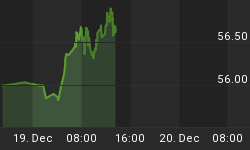
Federal Reserve Chairman Alan Greenspan's solution to every economic crisis has been to print more money - often by cutting rates which has the effect of increasing credit. The Alan Greenspan, who several decades ago clearly understood the Austrian school of economic thought (purge speculative excesses before they get out of hand) and the value of a gold-backed sound currency, is gone. Turned to the Darkside did he. With every scramble to frantically pump in credit at the first sign of a potential economic slowdown, Greenspan's transformation from a sound central banker (i.e. Paul Volcker) to an intellectually corrupted and pandering politician (seeking to keep the public working and the stock and real estate market bubbles propped up at all costs) was made more complete. The debt and deficit ridden economic house of cards that certain areas of the U.S. financial system have become was not going to collapse on his watch.
The Darth Greenspan Fed cut interest rates in 1998 partly due to the blowup of hedge fund Long Term Capital Management. When fears of Y2K hit the American populace in 1999, the chairman put his foot on the monetary pedal and increased liquidity to extreme levels. A significant amount of that newly created money found its way into Internet and other technology stocks fueling the greatest stock market bubble in history. As the NASDAQ bubble deflated in 2000-2002, Greenspan should have let the detoxification process take its course. Instead, he poured Americans another drink and cut rates again to their lowest levels since the Eisenhower administration, which spawned a colossal real estate bubble that still exists today. Greenspan's policy of extreme accommodation was accepted by the mainstream as critical weapons in the central bank's war against deflation.
Finally in 2004, Greenspan decided that his interest rate cuts had successfully done the trick of keeping the U.S. out of a Japanese-style deflation. Prices for everything were going up, especially in housing, raw materials, energy, and food. Fast forward to May 3, 2005 when the Fed hiked rates by a quarter-point to an even 3%, marking a cumulative increase of two full percentage points in the past ten months in the Fed Funds Rate. Now people are wondering what Greenspan will do next.
First of all, despite the Fed's talk about deflation, inflation has always existed and continues to rear its ugly head. The government's CPI data is bogus - no one that pays bills in this country really believes that inflation is only 2-3%. In fact, widespread worries of inflation are what have been prompting pundits to predict that the Fed will hike rates several more times before the year is over. But we see things a little bit differently. We think the Fed will only hike once or twice more before they are forced to deal with a slowing economy. As 2-year treasury rates move closer and closer to 10-year rates, fears of recession will be widespread and this could cause real problems in the banking & mortgage sectors. Moreover, if long term lending rates creep up, the credit and real estate bubbles may finally implode.
Are we predicting the Fed will start to cut rates this summer? No. Greenspan cannot cut because it will show that the Fed is worried about deflation again. A late 2002 type economic environment with fear and panic engendering widened credit/risk spreads and deflating asset prices may be unavoidable - and this time the Fed will be out of bullets. Greenspan's economic corner that he has painted himself into will likely mean that any attempt to cut rates could cause a run on the Dollar. Raising rates will likely shut down housing. Luckily for Greenspan his time as Fed Chairman is nearly up. His successor will be forced to deal with the ramifications of a highly levered economy that teeters into a severe recession. The Fed has always feared deflation more than inflation, so we think Greenspan will just try to hold things in place for another 7 months so that he can leave with his reputation unscathed.
more follows for subscribers . . .















